#Significance of Dussehra
Explore tagged Tumblr posts
Text

"HAPPY DUSSEHRA"#trending#viral
The importance of Happy Dussehra is deeply rooted in celebrating the triumph of good over evil, a tradition celebrated worldwide. In this we explore the significance of Dussehra, its spiritual and cultural relevance, and why this festival holds a special place in the hearts of millions. From its history to its current celebrations, we dive deep into how Happy Dussehra continues to inspire generations and its importance in fostering unity, strength, and positivity. Whether you're familiar with Dussehra or new to the festival, this will guide you through the profound meaning behind this joyous occasion. We also touch on how festivals like Dussehra provide opportunities for growth, learning, and understanding in both personal and cultural contexts. Join us as we celebrate the values and importance of Happy Dussehra, and discover how it continues to unite communities worldwide.
Call:7799799221
Website:www.manasadefenceacademy.com
#HappyDussehra #DussehraImportance #FestivalOfGoodOverEvil #DussehraCelebrations #DussehraSignificance #SpiritualMeaning #DussehraHistory #CulturalFestivals #CelebrateDussehra #IndianFestivals
#Happy Dussehra importance#Dussehra festival#spiritual meaning of Dussehra#significance of Dussehra#Dussehra celebration#why Dussehra is important#Indian cultural festivals#Dussehra worldwide#Dussehra history#Dussehra traditions#good over evil festival#importance of Dussehra#how to celebrate Dussehra#Dussehra meaning#cultural significance of Dussehra#Dussehra 2024#Happy Dussehra facts#Dussehra in India
1 note
·
View note
Text
Dussehra 2024 Date: When Is Vijayadashami? Know Shubh Muhurat, Significance, And Celebrations Across India | Culture News
Dussehra, one of the most revered festivals in Hinduism, will be celebrated across India on October 12, 2024. This festival, symbolizing the victory of good over evil, holds immense cultural and religious significance. Falling on the Dashami Tithi of the Shukla Paksha in the Hindu month of Ashwina, Dussehra marks the conclusion of the nine-day Navratri festival and the triumph of…
#Durga Victory Over Mahishasura#Dussehra 2024#Dussehra Date 2024#Dussehra Shubh Muhurat 2024#Navratri 2024#Rama Victory Over Ravana#Ravana Effigy Burning#Significance of Dussehra#Vijayadashami 2024
0 notes
Text
Dussehra, also known as Vijayadashami, is one of the major festivals of India. This festival is celebrated every year on the Dashami date of Shukla Paksha of Ashwin month. The festival of Dussehra symbolizes the victory of good over evil, And on this day Lord Ram had killed Ravana and established Dharma on the Earth.
#Dussehra 2024#Victory of good over evil#Vijayadashami#Dussehra Date 2024#Dussehra Puja Muhurta#Lord Ram#Ravana Dahan#Vijaya Dashami Tithi#Religious significance of Dussehra#Ramlila#Cultural festival#Method of Dussehra worship#Planetary position on Dussehra#Dussehra festival#Truth and dharma#Effigies of Ravana#Burning Ravana effigy#Dussehra celebration#Upcoming festival Diwali 2024
0 notes
Text
Vijayadashami/ Dussehra 2024: Embracing the Spirit of Giving and Compassion

Vijayadashami, also known as Dussehra, is a significant Hindu festival that commemorates the victory of good over evil. It marks the culmination of the nine-night Navratri celebration and heralds the upcoming Diwali festivities.
Key Aspects of Vijayadashami:
Celebration of Divine Victory: The festival honors the goddess Durga and Lord Rama for their triumphs over demonic forces.
Spirit of Giving: Vijayadashami emphasizes the importance of charity and compassion. Many people engage in acts of generosity to attract blessings and prosperity.
Ravan Dahan: One of the most anticipated events is the symbolic burning of Ravana’s effigy, representing the defeat of evil.
Ravan Dahan in 2024:
Date: Dussehra will be celebrated on October 24, 2024.
Auspicious Muhurat: The most auspicious time for Ravan Dahan is expected to fall between 6:00 PM and 8:00 PM on this day.
Cultural Significance of Dussehra:
Mythological Roots: The festival is deeply rooted in Hindu mythology, particularly the epic Ramayana.
Unity and Tradition: Dussehra promotes unity and strengthens cultural traditions.
Ayudhapuja: A related celebration, Ayudhapuja, honors tools and instruments, symbolizing craftsmanship and skill.
Dusshera Customs:
Ramlila: Enactments of the Ramayana story are performed in many regions.
Effigy Burning: The burning of Ravana’s effigy is a central ritual.
Puja: Various deities are worshipped during the festival.
Generosity: Charity and giving are integral parts of the celebrations.
Community and Social Cohesion:
Shared Experiences: Vijayadashami fosters a sense of community through shared rituals, meals, and celebrations.
Cultural Preservation: The festival helps preserve cultural heritage and traditions.
Inclusive Atmosphere: Vijayadashami promotes unity and inclusivity among people of different backgrounds.
What deities are worshipped during Dussehra?
Goddess Durga, Lord Rama, and Lord Ganesh are commonly worshipped during Dussehra.
What is the role of Daan (donation) during Ayudhapuja?
Charity and giving are believed to bring blessings and prosperity.
How does Dussehra promote community spirit?
Dussehra strengthens community bonds and promotes cultural heritage.
When is Ravan Dahan celebrated in 2024?
Ravan Dahan will be celebrated on October 24, 2024.
What is the significance of Ayudhapuja?
Ayudhapuja is a celebration honoring tools and instruments, symbolizing craftsmanship and skill.
What are some other customs associated with Dussehra?
Ramlila, effigy burning, puja, and generosity are some of the other customs associated with Dussehra.
#narayan seva sansthan#ngo#charity#donation#Dussehra 2024#Dussehra 2024 puja muhurat#dussehra 2024 date in india#Dussehra 2024 Date#Dussehra 2024 vrat katha#dussehra 2024 significance#dussehra 2024 time#dussehra 2024 rituals#vijayadashami 2024#vijayadashami 2024 date and time#vijayadashami 2024 date
0 notes
Text
Ganga Dussehra 2024: क्यों मनाया जाता है गंगा दशहरा, जानिए इसका पौराणिक महत्वगंगा दशहरा का त्योहार रविवार 16 जून को मनाया जाएगा। धार्मिक मान्यता के अनुसार, यह हिंदू धर्म का एक महत्वपूर्ण त्योहार है।
#ganga dussehra#ganga dussehra puja#ganga stotram#ganga stotram in hindi#ganga dussehra 2024 date#religion#religious significance of ganga dussehra#ganga dussehra spiritual#hindu parvDharm News in Hindi#Dharm News in Hindi#Dharm Hindi New
0 notes
Text
#Bhimakali Temple#Sarahan#Himachal Pradesh#Goddess Bhimakali#Hindu Temple#Religious Pilgrimage#Himalayan Architecture#Traditional Style#Religious Significance#Mythological Tales#Spiritual Experience#Panoramic Views CulturalHeritage#Dussehra Festival#Sacred Sanctuary#Devotional Journey#Himalayan Beauty#Divine Energy#Spiritual Upliftment#Pilgrimage Destination
0 notes
Note
Ooh so i was watching "Sawdes" And i thought what if desi reader and Lando watch that movie together and she explains all the small details to him, like the caste system and how rigid it was, and how it actually was in the villages and Lando's like very curious to know about India.

swades ⊹.˚🪞🕯️♡
ᡣ𐭩 ln x desi!reader ✬
ᡣ𐭩 fluff ✬
masterlist ☾☼

lando was sprawled out on the couch, legs stretched comfortably over the ottoman, a bowl of popcorn precariously balanced on his lap. the tv flickered with the opening credits of "swades," the soothing hum of the background score filling the cozy living room.
"so, what's this one about again?" lando asked, glancing at you with genuine curiosity.
you settle next to him, tucking your feet in under you. "it's a movie about this indian guy who works for nasa and then goes back to his roots and finds a need to give back to his community."
lando inclines his head. "sounds deep."
you smiled. "it is, but it's also very beautiful and so real."
as the movie started, you noticed lando's brows furrow slightly during the scenes that showed mohan—the protagonist—returning to his village. the dusty roads, the humble huts, and the villagers carrying out their daily routines seemed to intrigue him.
"wait, why's he sitting on the ground?" lando asked during a pivotal scene where a villager refused to sit on the same level as mohan.
you stopped the movie and turned to face him. "that's actually a huge part of india's history—the caste system. it's a strict social hierarchy that has been around for thousands of years. people were divided into different groups based on their jobs, and it determined where they could live, what they could do, and even who they could talk to."
lando's eyes widened. "seriously? that's awful. is it still like that now?"
"not officially," you said, picking at a stray thread on your sweater. "the indian government banned caste discrimination years ago, but in rural areas… it's complicated. traditions and mindsets don't change overnight."
he nodded slowly, digesting your words. "so that's why the guy didn't sit on the bench. he's… lower caste?"
"exactly," you said. "he probably grows up thinking he's not good enough for someone like mohan, who's educated and from the city. it's just sad."
lando sat back, scratching his head. "man, we brits really left a mess behind, huh?"
you snorted, unable to hold in the laugh that had begun to rise. "a bit of an understatement there, lando."
he grinned sheepishly. "alright, alright, point taken. i’ll add it to the list of things i’m apologizing for. right under the tea tax."
the movie continued, and you found yourself explaining more details to lando—how arranged marriages worked in rural India, why electricity and running water were still luxuries in many villages, and the deep cultural significance of festivals like dussehra. lando hung onto every word, his questions reflecting genuine interest.
"it's crazy to think about," he said during intermission. "like, i took so much stuff for granted-growing up—clean water, electricity, just even … being treated as an equal. and then this guy's coming to alter the way an entire village lives its life. inspiring,"
you smiled at him, a warmth spreading through your chest. "that's why i love this movie. it's not just a story; it's a reminder of where we come from and how much work there's still left to do."
"also a reminder that my ancestors were the worst," lando added, giving you a mock-serious look. "you're never letting me live this down, are you?"
"nope," you said, popping a piece of popcorn into your mouth. "you're stuck with me and my history lessons."
By the time the credits rolled, lando was wiping at his eyes, laughing sheepishly when you caught him. "alright, i'll admit… that hit harder than i expected."
you chuckled, leaning into his side. "told you it's a masterpiece."
he looked down at you, a thoughtful expression on his face. "you'll take me there one day, right? to india? i want to see it for myself."
your heart swelled at his sincerity. "absolutely. but only if you're ready for a sensory overload-the crowds, the colours, the chaos."
lando grinned. "bring it on. as long as i've got you to explain everything."
you smiled, reaching for his hand. "always."
you then realized just how lucky you were-to share a piece of your world with someone who cared enough to listen, to learn, and to embrace it wholeheartedly.
══✿══╡°˖✧✿✧˖°╞══✿══
i tried to add a little humour in this, but like, the movie itself is really serious, so i kept the fic a little serious too. i hope you like it! this is my prompt list, so y'all can select a number, give me a driver and i will write it as soon as possible! i also have a google form for a taglist if anyone's interested! you can sent in your requests here :)
taglist: @imlonelydontsendhelp ; @greantii ; @anamiad00msday ; @maketheshadowsfearyou ; @nocturnalherb16 ; @justaf1girl ; @peterholland04 ; @phobiccneel ; @winkev1
#lando norris#f1#formula 1#ln4#formula one#f1 imagine#lando norris imagine#lando norris x you#lando norris fanfic#lando norris x reader#lando norris x y/n#lando x reader#lando x you#lando imagine#lando x y/n#lando norris x desi!reader#lando x desi!reader#ln x reader
103 notes
·
View notes
Text
Hi Seekers,
This account is aimed at sharing contents about Hinduism. I'm eager to know from you and also want to share a few things I know about Sanatan Dharm.
Find my mundane form at:
EccentricAchiever
🚩🚩🚩🚩🚩🚩🚩🚩🚩🚩🚩🚩🚩🚩🚩🚩🚩🚩
LINKS:
AN IMPORTANT MESSAGE
Shiv Kathan:
When Lord Shiva appeared as Jyotisthambha
Markandeya and his devotion towards Lord Shiva
Background of Samudra Mathan and Lord Shiva consuming haalaahala
Destruction of Daksha Yagna
Lord Shiva annihilates Jalandhara
Lord Shiva blessing Maha Vishnu
Lord Shiva and the destruction of Kaama
Lord Shiva blessing Kuber
Series on Sanatani Saints:
Sanatani Saints Part 1 - Neem Karoli Baba
Sanatani Saints Part 2 - Shri Ramakrishna Paramahamsa
Sanatani Saints Part 3 - Shri Samartha Ramdas
Sanatani Saints Part 4 - Shri Sadhguru Shridhara swami
Other Sanatani topics:
What is Ashtavakr Geeta?
Greatness of Vyadha Geeta
Love Story of Dushyanta and Shakuntala. Why is it famous?
Is there anything more majestic than the vow of Bhishma?
Dussehra: Celebrating the Strength and Resilience of women
What is Niyog Paddati? Is it similar to modern-day cuckolding?
Wrath of the warriors: The Duel of Bhishma and Parashuram
Query on abhishek of Shivling
The tragic story of Ekalavya
Diwali and it's Significance
Maha Mrityunjaya Mantra
Sarpayaga of Parikshit
How to worship?
How Buddhism broke India's warrior Spirit?
Note on Raasleela of Shri Krishna
Request to Hindus
Yaksha prashna
Importance of Bhakti
Does free will exists or everything is predestined?
Something I felt about manusmriti and our need for external validation
What is Virodha Bhakti?
Why Murti Pooja is important in Hinduism?
Jyotish (Astrology) Topics:
When does the generous planet Jupiter become a fighter?
Astrology observations - Part 1
Astrology observations - Part 2
Tragedies of each ascendant
Dilemma
Important note regarding Rahu Dasha
Very important advice regarding Scorpio
18 notes
·
View notes
Text
Happy Dussehra #treanding#viralshorts#trendingshorts#dussehra
Happy Dussehra is a time to celebrate the victory of good over evil! In this, we will dive into the traditions, rituals, and unique ways to make this Dussehra extra special for you and your loved ones. Whether it's learning about the mythology behind the festival or discovering modern ways to celebrate, this has everything you need to know. From Ramayana’s lessons to decorating your home, and from organizing grand Dussehra events to intimate family gatherings, this is your ultimate guide.
Call:7799799221 Website:www.manasadefenceacademy.com
#HappyDussehra2024#DussehraCelebration#FestivalOfGoodOverEvil #DussehraTraditions#dussehrafestival#CelebrateDussehra#VictoryOfGoodOverEvil #DussehraVibes#DussehraSpecial#DussehraFacts#trending#viral#manasadefenceacademy
#Happy Dussehra#Dussehra celebration ideas#Dussehra 2024#Dussehra festival#Dussehra traditions#how to celebrate Dussehra#good over evil festival#Dussehra rituals#Ramayana and Dussehra#Dussehra family celebration#Indian festivals#Dussehra story#Dussehra activities#Dussehra home decoration#Dussehra festival significance#Dussehra puja#Dussehra celebrations#top Dussehra facts#Dussehra special festival#Dussehra in India
0 notes
Text
When Is Shardiya Navratri 2024: Dates, Colours, Rituals, And Significance Of The 9-day Festival | Culture News
Shardiya Navratri, also called Shrad Navratri, is a major Hindu festival that celebrates the nine forms of Goddess Durga. It takes place during the lunar month of Ashwin, usually between September and October. When is Shardiya Navratri 2024? In 2024, Shardiya Navratri will be celebrated from October 3 to October 12, with Dussehra falling on October 12. This festival is the most significant of…
#durga puja 2024#Dussehra 2024#Dusshera 2024#goddess durga#hindu festivals#Indian#Navratri Calendar#Navratri Colours#Navratri Rituals#Navratri significance#Shardiya Navratri#Shardiya Navratri 2024#Vijayadashami
1 note
·
View note
Text
Bommala Koluvu for Navaratri
Navaratri (Nava = nine, ratri = night), followed by Dussehra, is one of my favorite festivals of the year. I have many memories associated with it. Since my early teenage years, my mother and I would arrange a ‘Bommala Koluvu’ (Bommalu = dolls/idols, koluvu = arrangement) at home. Although it took almost a whole day to set up the steps and the idols/dolls, it was worth it. We would perform Pooja and other rituals in front of the Koluvu for all 10 days.
Note: Usually, in the culture that I come from, ‘Bommala Koluvu’ is observed during the festival of Sankranti but it can be observed during Navaratri and Deepavali, as well. My mother did this for both Sankranti and Navaratri.
Normally, people have the steps pre-built so that they don’t have to be arranged each for each festival it is used for. However, in our home, the steps were arranged differently. My mother did want to be restricted by the uniform size of the steps, which she would be if she had them built. She, instead, kept a few of our old furniture, like center tables, side tables and some cardboard boxes and used them specifically for the Bommala Koluvu. My mother and I would then cover the steps with a white or off-white cloth so the dolls would show up. We had almost 5 or 6 large moving boxes full of the dolls we would use to arrange on the steps. The set up of the steps and the white cloth would take most of our time. Arranging the dolls was the easy part.
What is the meaning behind this tradition?
The significance behind this tradition is that it pays homage to Goddess Mahishasura Mardhini (an avatar of Goddess Durga) who fought an epic battle against the demon, Mahishasura. It is Her victory that is celebrated during Navaratri. Another meaning behind the Bommala Koluvu is to tell multiple stories from South Indian mythology. It can range from scenes from Ramayan, Mahabharat, Srimad Bhagavatam and Krishna Leela. Some modern arrangements have specific themes like Sri Krishna Leela which focuses on stories ranging from Krishna’s birth to his marriages.
One of our family friends once did a Lord Ganesha themed Bommala Koluvu. In our home, we arrange a Vrindaavan on one side which shows all of Lord Krishna’s childhood. On the other side, we would arrange Kailasam (Lord Shiva’s abode) and in the middle we would arrange seven steps where each step would be dedicated to a Hindu God. For example, the first step would be for Goddess Durga and her avatars., the second step for Ashta Lakshmi (Ashta = 8), the third step for Lord Vishnu, and etc.
The best part of this tradition is that you can be as creative as you like. There are no rules on how the dolls should be arranged. And there are no restrictions as to what kind of idols and dolls you want to put in your Bommala Koluvu. You can even include some of your show pieces to make it look even more pretty!
Cultural Aspect
Bommala Koluvu is a great way to teach young children about our ancient culture, traditions, customs, mythology and the Puranas. It is also a creative of storytelling with live visuals. When dolls/idols are arranged this way, kids will be curious to learn more about each character and scenario being depicted. Plus, it also gives kids a chance to participate in the worship of Goddess Durga.
Social Significance
In the past, Hindu families were very orthodox which meant that women were did have the time to step out and catch up with friends. Moreover, some women were not permitted to leave the house as well.
The best part about Bommala Koluvu is that whoever is hosting invites friends, relatives, neighbors and so on. This is my favorite part because it meant that all our friends and relatives from all over California used to come over to our home and spend the whole night catching up with each other. This tradition ensures that friendships become stronger and helps women maintain their friendships since they can get caught up in their personal lives.
Economic Significance
India is an agricultural country where traditions like Bommala Koluvu and agriculture are related. Back in the day, the idols, dolls, and other items featured in a Bommala Koluvu were made with clay, wood, wax, glass, stone, etc. and were painted with natural paints. India is also home to many traditional handicrafts such as terracotta, Kondapalli, cloth dolls and more.
By purchasing these handcrafted items for Bommala Koluvu, the artists are encouraged to make more of them each season. All of the idols we have a home are made of clay, glass, and wood. We also have Kondapalli Bommalu (dolls) that have been passed down from my great grandmother. Another perk to purchasing these handcrafted, natural items is that they are eco-friendly!
Although arranging the dolls was tiring, catching up with friends, relatives and neighbors was made all the hard work worth it. Plus, there would a lot of leftover good food which we would eat for the next couple of days.
I hope you all enjoyed getting to more about this fun little tradition! Comment down below about a tradition you follow at your home for Navaratri!
~ The Saffron Muse
3 notes
·
View notes
Text
Navratri is a nine-night Hindu festival celebrating the goddess Durga It involves fasting, feasting. 🌟 Happy Navratri! 🌟
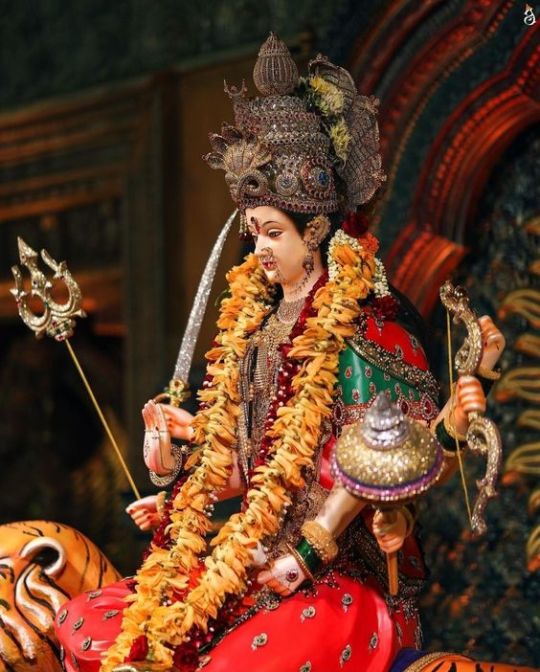
Navratri is a vibrant Hindu festival celebrated with great fervor and enthusiasm across India and by Hindus around the world. The word 'Navratri' literally translates to "nine nights" in Sanskrit, and the festival spans nine nights and ten days, dedicated to the worship of the Hindu goddess Durga and her various forms. Navratri typically falls in the Hindu lunar month of Ashvin , which usually corresponds to September or October in the Gregorian calendar.
Here are some key aspects and traditions associated with Navratri:
Worship of Goddess Durga: Navratri honors the divine feminine energy, particularly Goddess Durga, who symbolizes courage, power, and victory over evil. Each of the nine days is dedicated to one of her different forms, known as Navadurga. These forms include Shailaputri, Brahmacharini, Chandraghanta, Kushmanda, Skandamata, Katyayani, Kalaratri, Mahagauri, and Siddhidatri.
Fasting and Feasting: Fasting is a common practice during Navratri, where devotees abstain from consuming certain foods or have strict diets. Some may observe complete fasting, while others may abstain from specific food items like grains, onion, garlic, and non-vegetarian food. The fasts are believed to purify the body and mind and enhance spiritual practices. At the same time, special Navratri delicacies are prepared and shared among family and friends, including dishes like sabudana khichdi, kuttu ki puri, and singhare ka halwa, made with ingredients permissible during fasting.
Garba and Dandiya Raas: One of the highlights of Navratri celebrations is the vibrant and colorful Garba and Dandiya Raas dances. Garba involves circular formations where participants dance gracefully in traditional attire, often accompanied by devotional songs praising the goddess. Dandiya Raas, on the other hand, involves energetic and rhythmic dance performances with sticks (dandiyas) held in each hand, symbolizing the playful combat between Goddess Durga and the demon Mahishasura.
Golu or Bommai Kolu: In South India, particularly in Tamil Nadu and Karnataka, Navratri is celebrated through the tradition of Golu or Bommai Kolu. During this custom, dolls and figurines representing various deities and mythological characters are displayed on steps or shelves adorned with colorful decorations. Visitors are invited to homes to view the display, and it's considered auspicious to offer prayers and seek blessings during this time.
Vijayadashami: Navratri culminates on the tenth day with Vijayadashami or Dussehra, which marks the triumph of good over evil. This day is significant for various reasons, including the victory of Lord Rama over the demon king Ravana in the epic Ramayana. In many parts of India, effigies of Ravana, Megh nath, and Kum bhakarna are burnt to symbolize the victory of righteousness.
#hindu festival#festival navratri#festival#festivegifts#festival Navratri#hindu gods#hinduism#mahadev#lord shiva#india#hindu sahiban nahi samjhe gita ved puran#Hindu festival
5 notes
·
View notes
Text
fellow writers and artists, I'm looking for a list of women who were wronged and/or painted as the bad guys in mythology. example: Medusa (Greek mythology), Ahalya (Hindu mythology), Lilith (Christianity), etc.
Please drop the names of these women (and this is inclusive of trans women/AFAB individuals) + which culture/religion/mythology/epic they come from. Also if there's a cultural significance, pls let me know what is it? For example; the Hindu mythology that Ahalya's story is - Ramayan - is also the folktale behind one of the most celebrated festivals in India, Dussehra and Diwali. We hear her story once, and then rarely hear of her again. We also have Sita, Kaikeyi and many more women who have been wronged but are also to blame for many things in Ramayana. I have beef with Ram.
It's alright if these myths are also popular, and if there's an existing feminist retelling. Feel free to info dump about this very niche thing!
#greek mythology#indian mythology#ramayana#mahabharata#medusa#christianity#theology#religion#culture#art#writing#anthropology
13 notes
·
View notes
Text
10 Beautiful Vocabulary for the Navratri Celebration

Navratri Spirit: Honoring Goddess Durga
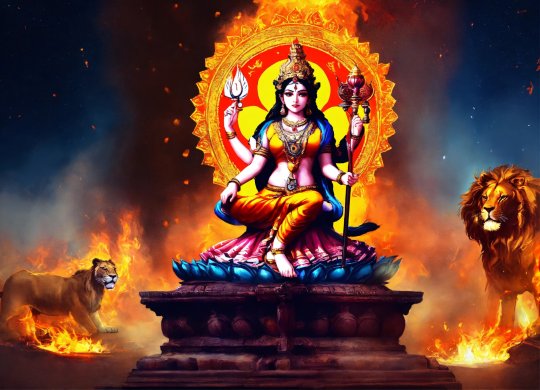
The vibrant spirit of India comes alive during Navratri, a nine-day festival that resonates with faith, festivity, and cultural grandeur. As the name suggests, "Nav" means nine and "Ratri" means nights. This festival is a joyous period steeped in beautiful traditions and customs. Let's delve into the dazzling world of Navratri with some exquisite vocabulary to enrich your understanding of this spectacular celebration.
1. Auspicious (au-spish-us)

Navratri is considered an extremely auspicious time. "Auspicious" signifies an occasion filled with good fortune and blessings. Devotees believe that prayers and observances undertaken during these nine nights hold special significance and bring prosperity.
2. Reverence (rev-er-ence)
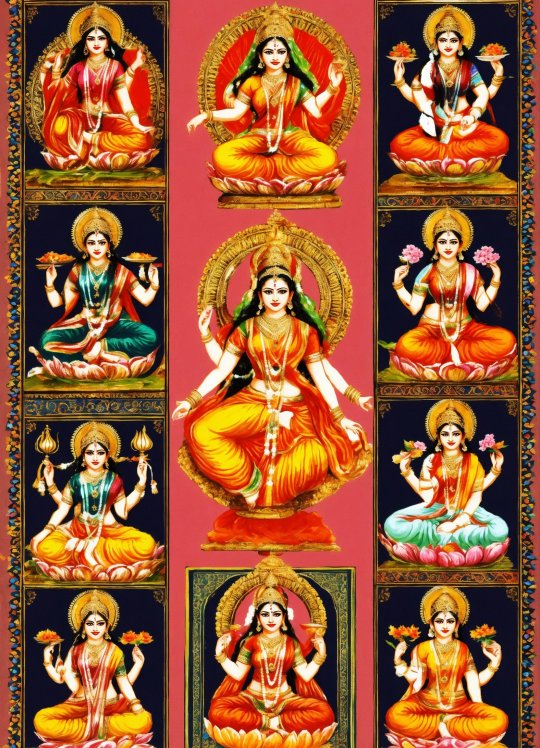
The nine days of Navratri are dedicated to worshipping the nine divine forms of Goddess Durga. "Reverence" refers to the deep respect and devotion offered to the Goddess. Hindus across the world observe pujas (prayers) and rituals with utmost reverence, seeking the blessings of Durga for strength, wisdom, and protection.
3. Panoply (pan-o-ply)

Navratri is a visual feast for the senses. Homes and pandals (temporary shrines) are adorned with vibrant decorations, creating a dazzling "panoply" of colors and textures. Imagine intricate rangolis (floor art), strings of marigolds, and shimmering diyas (lamps) – a true spectacle of beauty.
4. Ethereal (ee-the-ri-al)

The atmosphere during Navratri is charged with a sense of otherworldly beauty. "Ethereal" describes something delicate and heavenly, and this perfectly captures the feeling one gets amidst the chants, devotional music, and the gentle flickering of diya flames.
5. Resplendent (ri-splen-dent)

Devotees dress up in their finest attire during Navratri. "Resplendent" signifies being magnificently beautiful and radiant. Imagine sarees in rich silks, adorned with intricate jewellery – a dazzling display of cultural resplendence.
6. Gastronomical (gas-tro-no-mi-cal)
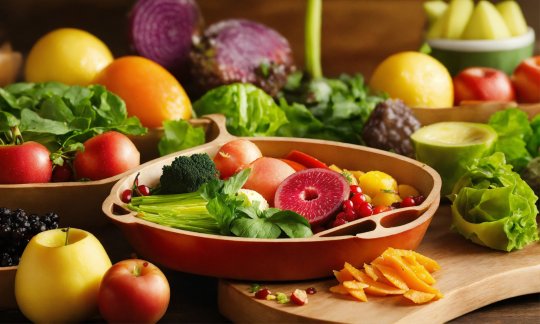
Navratri is a time to indulge in delicious vegetarian fare. "Gastronomical" refers to the art of good eating, and Navratri offers a plethora of delectable dishes specially prepared for the occasion. Think of flavorful sweets like halwa and savoury dishes like sabudana khichdi – a true treat for the taste buds.
CREATE YOUR DREAM BOOK NOW
7. Jubilant (joo-bi-lant)
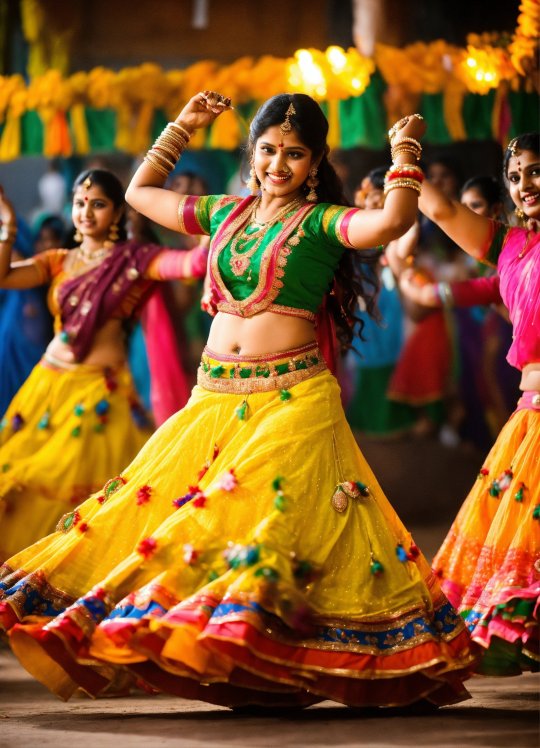
The spirit of Navratri is infectious. The air is filled with the sounds of laughter, music, and joyous celebrations. "Jubilant" describes a feeling of great happiness and triumph, perfectly capturing the mood of this vibrant festival.
8. Propitious (pro-pish-us)

The tenth day after Navratri, Dussehra, marks the victory of good over evil. "Propitious" signifies favorable or auspicious. Dussehra is seen as a day that ushers in good times and eliminates negativity.
9. Confluence (con-flu-ence)

Navratri transcends religious boundaries and brings people together. "Confluence" signifies a flowing together, and this beautifully captures the spirit of the festival. People from all walks of life come together to celebrate, share stories, and strengthen community bonds.
10. Euphoria (yoo-for-ee-ah)

Navratri leaves a lasting impression. "Euphoria" describes a feeling of intense happiness and excitement. The festival leaves devotees feeling uplifted, inspired, and carrying the positive energy forward throughout the year.
Beyond the Words: The Enchantment of Navratri
These words merely offer a glimpse into the magic of Navratri. The true essence of the festival lies in experiencing it firsthand. The aroma of incense filling the air, the rhythmic beats of the dhol (drum), the vibrant colours, and the feeling of community – all contribute to creating an unforgettable experience.
So, if you have the opportunity to witness Navratri, embrace it with open arms. Let yourself be enveloped by the joyous spirit, savour the delicious food, and appreciate the beauty of this time-honoured tradition. You might discover a new facet of Indian culture and return home with a heart brimming with "euphoria."
Don't miss out on our other blog posts!
2 notes
·
View notes
Text
Dussehra and Vijayadashami: The Triumph of Good over Evil
Do you want to know how to celebrate Dussehra and Vijayadashami, the Hindu festival of victory? Read this article to find out.
Dussehra and Vijayadashami are two names for the same Hindu festival that celebrates the victory of good over evil. It is one of the most important and popular festivals in India, as well as in other countries where Hinduism is practiced. In this article, you will learn about the history, mythology, significance, celebrations, and astrology of this festival. You will also discover some tips and…

View On WordPress
#: dussehra 2023 date#Dussehra#dussehra and vijayadashami in different regions of india#dussehra celebrations#dussehra images#dussehra rituals#dussehra significance#festival of victory#good vs evil#hindu festivals#how to celebrate dussehra at home#how to celebrate vijayadashami at home#indian culture#indian festivals#indian traditions#ramlila#ravana#triumph of good#vijayadashami#vijayadashami 2023 date#vijayadashami history#vijayadashami images#vijayadashami mythology
0 notes
Text
MAA DURGA
Maa Durga, also known as Goddess Durga, is a powerful and widely revered deity in Hinduism. She is considered the embodiment of feminine energy and is worshiped as the divine mother and the supreme goddess.
👑 Maa Durga is often depicted as a beautiful and fierce goddess with multiple arms, each holding a weapon. She rides a lion or tiger, symbolizing power and bravery. Her image represents the triumph of good over evil.
🗡️ According to Hindu mythology, Maa Durga was created by the combined energies of various deities to defeat the buffalo demon Mahishasura, who was causing chaos and terror in the world. It is believed that she fought a fierce battle with Mahishasura for nine nights and ultimately defeated him on the tenth day, known as Vijayadashami or Dussehra.
🎉 The festival of Navaratri, meaning "nine nights," is dedicated to the worship of Maa Durga. It is celebrated with great enthusiasm and devotion in many parts of India and by Hindu communities around the world. During Navaratri, various forms of the goddess are worshiped, and traditional dances and music performances called "Garba" and "Dandiya" are organized.
🪔 The most popular time to worship Maa Durga is during the festival of Durga Puja, which is widely celebrated in the Indian states of West Bengal, Odisha, Assam, and other parts of India. Elaborately crafted idols of the goddess are worshipped in temporary structures called pandals, and grand processions, cultural performances, and feasts are organized during this time.
🌺 Maa Durga is believed to possess various divine qualities and attributes. She is considered the embodiment of power (Shakti), motherly love, compassion, and righteousness. Devotees seek her blessings for protection, prosperity, and spiritual fulfillment.
🙏 The prayers and hymns dedicated to Maa Durga, such as the Durga Chalisa and the Devi Stuti, are chanted by devotees to invoke her blessings and seek her divine intervention in their lives.
🌼 Maa Durga is not only worshipped by Hindus but is also respected and revered by people of different faiths as a symbol of strength, courage, and feminine power.
🔱 Overall, the worship of Maa Durga holds immense significance in Hinduism, and she is revered as the divine mother who protects her devotees and removes obstacles from their lives.
2 notes
·
View notes